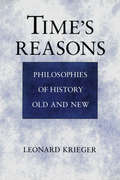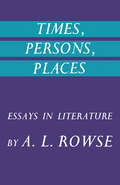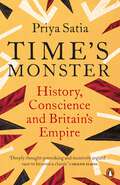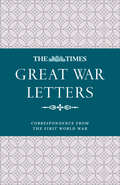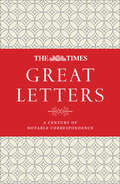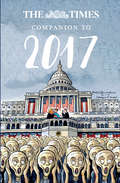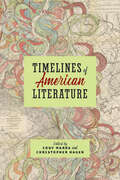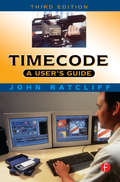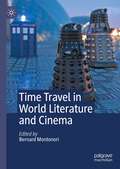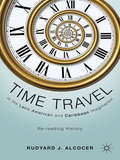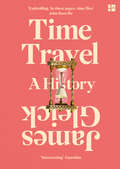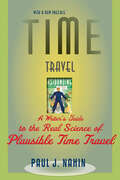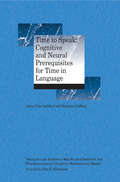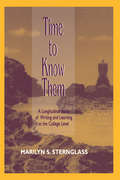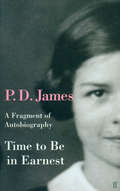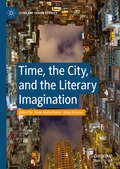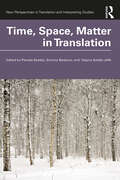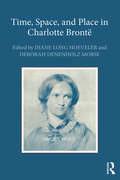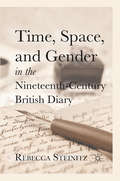- Table View
- List View
Time's Reasons: Philosophies of History Old and New
by Leonard KriegerThis original work caps years of thought by Leonard Krieger about the crisis of the discipline of history. His mission is to restore history's autonomy while attacking the sources of its erosion in various "new histories," which borrow their principles and methods from disciplines outside of history. Krieger justifies the discipline through an analysis of the foundations on which various generations of historians have tried to establish the coherence of their subject matter and of the convergence of historical patterns. The heart of Krieger's narrative is an insightful analysis of theories of history from the classical period to the present, with a principal focus on the modern period. Krieger's exposition covers such figures as Ranke, Hegel, Comte, Marx, Acton, Troeltsch, Spengler, Braudel, and Foucault, among others, and his discussion involves him in subtle distinctions among terms such as historism, historicism, and historicity. He points to the impact on history of academic political radicalism and its results: the new social history. Krieger argues for the autonomy of historical principles and methods while tracing the importation in the modern period of external principles for historical coherence. Time's Reasons is a profound attempt to rejuvenate and restore integrity to the discipline of history by one of the leading masters of nineteenth- and twentieth-century historiography. As such, it will be required reading for all historiographers and intellectual historians of the modern period.
Time's Monster: History, Conscience and Britain's Empire
by Priya Satia'In this searing book, Priya Satia demonstrates, yet again, that she is one of our most brilliant and original historians' Sunil Amrith, author of Unruly WatersFor generations, the history of the British empire was written by its victors. British historians' accounts of conquest guided the consolidation of imperial rule in India, the Middle East, Africa and the Caribbean. Their narratives of the development of imperial governance licensed the brutal suppression of colonial rebellion. Their reimagining of empire during the two world wars compromised the force of decolonization.In this brilliant work, Priya Satia shows how these historians not only interpreted the major political events of their time but also shaped the future that followed. History emerged as a mode of ethics in the modern period, endowing historians from John Stuart Mill to Winston Churchill with outsized policymaking power. Braided with this story is an account of alternative visions articulated by anticolonial thinkers such as William Blake, Mahatma Gandhi and E. P. Thompson. By the mid-twentieth century, their approaches had reshaped the discipline of history and the ethics that came with it.Time's Monster reveals the dramatic consequences of writing history today as much as in the past. Against the backdrop of enduring global inequalities and debates about reparations and the legacy of empire, Satia offers us a hugely important and urgent moral voice.
The Times Great War Letters: Correspondence During The First World War
by James Owen Samantha WyndhamSelection of more than 300 letters published by The Times newspaper between 1914 and 1918, as its readers and the nation alike endured the ordeal of the First World War.
The Times Great Letters: Notable Correspondence To The Newspaper
by James OwenThe Times has the most famous letters page of any newspaper. This delightful selection of over 300 items of correspondence over the last century shows precisely why.
The Times Companion to 2017: The Best Writing From The Times
by The TimesA year of political upheaval, sporting thrills, and continuing global conflict. The Times Companion to 2017 is a selection of authoritative and entertaining writing on politics, war, culture, sport and current affairs from the world’s most famous newspaper.
Timelines of American Literature
by Cody Marrs Christopher HagerIt is all but inevitable for literary history to be divided into periods. "Early American," "antebellum," "modern," "post-1945";¢;‚¬;€?such designations organize our knowledge of the past and shape the ways we discuss that past today. These periods tend to align with the watershed moments in American history, even as the field has shifted its perspective away from the nation-state. It is high time we rethink these defining periods of American literary history, as the drawing of literary timelines is a necessary;¢;‚¬;€?even illuminating;¢;‚¬;€?practice.In these short, spirited, and imaginative essays, 23 leading Americanists gamely fashion new, unorthodox literary periods;¢;‚¬;€?from 600 B.C.E. to the present, from the Age of Van Buren to the Age of Microeconomics. They bring to light literary and cultural histories that have been obscured by traditional timelines and raise provocative questions. What is our definition of "modernism" if we imagine it stretching from 1865 to 1965 instead of 1890 to 1945? How does the captivity narrative change when we consider it as a contemporary, not just a "colonial," genre? What does the course of American literature look like set against the backdrop of federal denials of Native sovereignty or housing policies that exacerbated segregation? Filled with challenges to scholars, inspirations for teachers (anchored by an appendix of syllabi), and entry points for students, Timelines of American Literature gathers some of the most exciting new work in the field to showcase the revelatory potential of fresh thinking about how we organize the literary past.
Timelines of American Literature
by Cody Marrs Christopher HagerIt is all but inevitable for literary history to be divided into periods. "Early American," "antebellum," "modern," "post-1945";¢;‚¬;€?such designations organize our knowledge of the past and shape the ways we discuss that past today. These periods tend to align with the watershed moments in American history, even as the field has shifted its perspective away from the nation-state. It is high time we rethink these defining periods of American literary history, as the drawing of literary timelines is a necessary;¢;‚¬;€?even illuminating;¢;‚¬;€?practice.In these short, spirited, and imaginative essays, 23 leading Americanists gamely fashion new, unorthodox literary periods;¢;‚¬;€?from 600 B.C.E. to the present, from the Age of Van Buren to the Age of Microeconomics. They bring to light literary and cultural histories that have been obscured by traditional timelines and raise provocative questions. What is our definition of "modernism" if we imagine it stretching from 1865 to 1965 instead of 1890 to 1945? How does the captivity narrative change when we consider it as a contemporary, not just a "colonial," genre? What does the course of American literature look like set against the backdrop of federal denials of Native sovereignty or housing policies that exacerbated segregation? Filled with challenges to scholars, inspirations for teachers (anchored by an appendix of syllabi), and entry points for students, Timelines of American Literature gathers some of the most exciting new work in the field to showcase the revelatory potential of fresh thinking about how we organize the literary past.
Timecode A User's Guide: A user's guide (Music Technology Ser.)
by J. RatcliffRecent radical changes in timecode technology, location shooting and post-production working practices have been brought about by the fragmentation of the television programme making industry and by a dramatic increase in affordable digital transmission and editing equipment and systems.With the expansion of non-traditional television service producers (cable, satellite and video-on-demand) almost anything hoes as far as shooting and editing formats are concerned. Timecode: A User's Guide is an indispensable reference for anyone needing to get to grips with the many aspects of timecode, whether in-house or on location.Taking into account these changes this book has now been brought completely up to date to include:* timecode and DVD, LTC & VITC in HANC packets in the serial digital TV interfaces * timecode in IEEE1395 (Firewire)* timecode and digital video cassettes* new recording formats of DVD, DV mini cassettes and D6 are included* 4:3 scanning for wide-screen films - standards updated* new material to cover new working practices* new appendices to cover the global LF time data transmissions and time data embedded in BBC transmissionsAdvice is also given on avoiding and remedying faults and errors.
Timecode A User's Guide: A user's guide
by J. RatcliffRecent radical changes in timecode technology, location shooting and post-production working practices have been brought about by the fragmentation of the television programme making industry and by a dramatic increase in affordable digital transmission and editing equipment and systems.With the expansion of non-traditional television service producers (cable, satellite and video-on-demand) almost anything hoes as far as shooting and editing formats are concerned. Timecode: A User's Guide is an indispensable reference for anyone needing to get to grips with the many aspects of timecode, whether in-house or on location.Taking into account these changes this book has now been brought completely up to date to include:* timecode and DVD, LTC & VITC in HANC packets in the serial digital TV interfaces * timecode in IEEE1395 (Firewire)* timecode and digital video cassettes* new recording formats of DVD, DV mini cassettes and D6 are included* 4:3 scanning for wide-screen films - standards updated* new material to cover new working practices* new appendices to cover the global LF time data transmissions and time data embedded in BBC transmissionsAdvice is also given on avoiding and remedying faults and errors.
Time Travel in World Literature and Cinema
by Bernard MontoneriTime Travel in World Literature and Cinema discusses various literary works, movies, and TV series with a special focus on time travel. Each chapter is written by professors and scholars from various countries, including the US, Japan, Germany, France, Spain, Taiwan, South Africa, Qatar, Russia, Ukraine and Australia. The book addresses themes of racism, sexism, feminism, and social injustice as well as dystopian futures. This will appeal to students and scholars studying science fiction, dystopian literature, world literature, and world cinema.
Time Travel in the Latin American and Caribbean Imagination: Re-reading History
by R. AlcocerCombining in innovative ways the tools and approaches of postcolonial and popular culture studies as well as comparative literary analysis, this is an ambitious, interdisciplinary study that develops - across several related discursive sites - an argument about the centrality of time travel in the Latin American and Caribbean imagination.
Time Travel: A Brief History Of Time Travel
by James GleickAN OBSERVER BOOK OF THE YEAR From the acclaimed author of The Information and Chaos, a mind-bending exploration of time travel: its subversive origins, its evolution in literature and science, and its influence on our understanding of time itself.
Time Travel: A Writer's Guide to the Real Science of Plausible Time Travel (Science And Fiction Ser.)
by Paul J. NahinFrom H.G. Wells to Isaac Asimov to Ursula K. Le Guin, time travel has long been a favorite topic and plot device in tales of science fiction and fantasy. But as any true SF fan knows, astounding stories about traversing alternate universes and swimming the tides of time demand plausible science. That’s just what Paul J. Nahin’s guide provides.An engineer, physicist, and published science fiction writer, Nahin is uniquely qualified to explain the ins and outs of how to spin such complex theories as worm holes, singularity, and relativity into scientifically sound fiction. First published in 1997, this fast-paced book discusses the common and not-so-common time-travel devices science fiction writers have used over the years, assesses which would theoretically work and which would not, and provides scientific insight inventive authors can use to find their own way forward or backward in time. From hyperspace and faster-than-light travel to causal loops and the uncertainty principle and beyond, Nahin’s equation-free romp across time will help writers send their characters to the past or future in an entertaining, logical, and scientific way.If you ever wanted to set up the latest and greatest grandfather paradox—or just wanted to know if the time-bending events in the latest pulp you read could ever happen—then this book is for you.
Time to Speak: Cognitive and Neural Prerequisites for Time in Language
by Peter Indefrey Marianne GullbergTime is a fundamental aspect of human cognition and action. All languages have developed rich means to express various facets of time, such as bare time spans, their position on the time line, or their duration. This volume explores what we know about the neural and cognitive representations of time that speakers can draw on in language. Considers the role time plays as an essential element of human cognition and action, providing important insights to inform and extend current studies of time in language and in language acquisition Examines the main devices used to encode time in natural language, such as lexical elements, tense, and aspect, and draws on the latest psychological and neurobiological findings Addresses a range of issues, including: the relationship between temporal language, culture, and thought; the relationship between verb aspect and mental simulations of events; the development of temporal concepts; time perception; the storage and retrieval of temporal information in autobiographical memory; and neural correlates of tense processing and sequence planning
Time To Know Them: A Longitudinal Study of Writing and Learning at the College Level
by Marilyn S. SternglassIn a time of declining resources in institutions of higher education, we grapple with how priorities are to be set for the limited resources available. Most vulnerable are those students labeled underprepared by colleges and universities. Should we argue that the limited resources available ought to be used to support these students through their undergraduate years? And, if we decide that we want to do that, what evidence of their potential for success can we provide that will justify the use of these resources? Through longitudinal research that follows students who have been so labeled over all their college years, we can begin to find answers to these questions. Time to Know Them is the first book that follows the experiences of a group of students over their entire academic experience. No previous studies have brought together the factors incorporated in this study: *examining writing and learning on a true longitudinal basis; *studying a multicultural urban population; *investigating the relationship between writing and learning by examining papers written over time for regularly assigned academic courses across a range of disciplines; and *taking into consideration non-academic factors that influence academic performance such as race, gender, socio-economic status, and ideological orientation. Through interviews twice a semester over six years, the collection of papers written for all courses, observations of instructional settings, and analysis of required institutional tests of writing, the author has been able to pull together a more complete picture of writing and intellectual development over the college years than has previously been available in any study. Students are seen to acquire the ability to handle more complex reasoning tasks as they find themselves in more challenging intellectual settings and where risk-taking and exploration of new ideas are valued. The integration of students' previous life experiences into their academic studies allows them to analyze, critique, modify, and apply their previously held world views to their new learning. These changes are seen to occur over time with instructional settings and support providing key roles in writing development. Personal factors in students' lives present difficulties that require persistence and dedication to overcome. Never before have the complexities of real individual lives as they affect academic performance been so clearly presented.
Time To Know Them: A Longitudinal Study of Writing and Learning at the College Level
by Marilyn S. SternglassIn a time of declining resources in institutions of higher education, we grapple with how priorities are to be set for the limited resources available. Most vulnerable are those students labeled underprepared by colleges and universities. Should we argue that the limited resources available ought to be used to support these students through their undergraduate years? And, if we decide that we want to do that, what evidence of their potential for success can we provide that will justify the use of these resources? Through longitudinal research that follows students who have been so labeled over all their college years, we can begin to find answers to these questions. Time to Know Them is the first book that follows the experiences of a group of students over their entire academic experience. No previous studies have brought together the factors incorporated in this study: *examining writing and learning on a true longitudinal basis; *studying a multicultural urban population; *investigating the relationship between writing and learning by examining papers written over time for regularly assigned academic courses across a range of disciplines; and *taking into consideration non-academic factors that influence academic performance such as race, gender, socio-economic status, and ideological orientation. Through interviews twice a semester over six years, the collection of papers written for all courses, observations of instructional settings, and analysis of required institutional tests of writing, the author has been able to pull together a more complete picture of writing and intellectual development over the college years than has previously been available in any study. Students are seen to acquire the ability to handle more complex reasoning tasks as they find themselves in more challenging intellectual settings and where risk-taking and exploration of new ideas are valued. The integration of students' previous life experiences into their academic studies allows them to analyze, critique, modify, and apply their previously held world views to their new learning. These changes are seen to occur over time with instructional settings and support providing key roles in writing development. Personal factors in students' lives present difficulties that require persistence and dedication to overcome. Never before have the complexities of real individual lives as they affect academic performance been so clearly presented.
Time to Be in Earnest: A Fragment Of Autobiography (Biography Ser.)
by P. D. JamesIn this intriguing and very personal book, part diary, part memoir, P.D. James considers the twelve months of her life between her 77th and 78th birthdays, 'a time to be in earnest', as Dr Johnson said at the comparable moment of his very different life two centuries ago. In recording the events, thoughts and reflections of her present, Baroness James has found herself simultaneously remembering the past of her remarkable career. She recalls what it was like to be a schoolgirl in the 1920s and 1930s in Cambridge, then giving birth to her second daughter during the worst of the Doodlebug bombardment in London during the war, working as an administrator in the National Health Service, entering the Home Office in the forensic and criminal justice departments, serving as a Governor of the BBC, an influential member of the British Council, the Arts Council and the Society of Authors, and eventually entering the House of Lords.Along the way, this diary and personal memoir deals with her burgeoning reputation as a novelist, starting with Cover Her Face in 1962, and with the craft of the classical detective story. During this busy year she also published one of her most intriguing and carefully researched books, A Certain Justice. This record of twelve months in a life of creativity and public service, told with honesty and perception, will enthral aficionados of detective fiction. It will also appeal to those who themselves have lived through the turbulent years of the twentieth century. P.D. James is the bestselling author of Death Comes to Pemberley and Children of Men, both of which have been adapted for film, with actors such as Michael Caine, Clive Owen and Jenna Coleman playing leading roles.
Time, the City, and the Literary Imagination (Literary Urban Studies)
by Anne-Marie Evans Kaley KramerTime, the City, and the Literary Imagination explores the relationship between the constructions and representations of the relationship between time and the city in literature published between the late eighteenth century and the present. This collection offers a new way of reading the literary city by tracing the ways in which the relationship between time and urban space can shape literary narratives and forms. The essays consider the representation of a range of literary cities from across the world and consider how an understanding of time, and time passing, can impact on our understanding of the primary texts. Literature necessarily deals with time, both as a function of storytelling and as an experience of reading. In this volume, the contributions demonstrate how literature about cities brings to the forefront the relationship between individual and communal experience and time.
Time, Space, Matter in Translation (New Perspectives in Translation and Interpreting Studies)
by Pamela Beattie Simona Bertacco Tatjana Soldat-JaffeTime, Space, Matter in Translation considers time, space, and materiality as legitimate habitats of translation. By offering a linked series of interdisciplinary case studies that show translation in action beyond languages and texts, this book provides a capacious and innovative understanding of what translation is, what it does, how, and where. The volume uses translation as a means through which to interrogate processes of knowledge transfer and creation, interpretation and reading, communication and relationship building—but it does so in ways that refuse to privilege one discipline over another, denying any one of them an entitled perspective. The result is a book that is grounded in the disciplines of the authors and simultaneously groundbreaking in how its contributors incorporate translation studies into their work. This is key reading for students in comparative literature—and in the humanities at large—and for scholars interested in seeing how expanding intellectual conversations can develop beyond traditional questions and methods.
Time, Space, Matter in Translation (New Perspectives in Translation and Interpreting Studies)
by Pamela Beattie Simona Bertacco Tatjana Soldat-JaffeTime, Space, Matter in Translation considers time, space, and materiality as legitimate habitats of translation. By offering a linked series of interdisciplinary case studies that show translation in action beyond languages and texts, this book provides a capacious and innovative understanding of what translation is, what it does, how, and where. The volume uses translation as a means through which to interrogate processes of knowledge transfer and creation, interpretation and reading, communication and relationship building—but it does so in ways that refuse to privilege one discipline over another, denying any one of them an entitled perspective. The result is a book that is grounded in the disciplines of the authors and simultaneously groundbreaking in how its contributors incorporate translation studies into their work. This is key reading for students in comparative literature—and in the humanities at large—and for scholars interested in seeing how expanding intellectual conversations can develop beyond traditional questions and methods.
Time, Space, and Place in Charlotte Brontë
by Deborah Denenholz Morse Diane Long HoevelerOrganized thematically around the themes of time, space, and place, this collection examines Charlotte Brontë in relationship to her own historical context and to her later critical reception, takes up the literal and metaphorical spaces of her literary output, and sheds light on place as both a psychic and geographical phenomenon in her novels and their adaptations. Foregrounding both a historical and a broad cultural approach, the contributors also follow the evolution of Brontë's literary reputation in essays that place her work in conversation with authors such as Samuel Richardson, Walter Scott, and George Sand and offer insights into the cultural and critical contexts that influenced her status as a canonical writer. Taken together, the essays in this volume reflect the resurgence of popular and scholarly interest in Charlotte Brontë and the robust expansion of Brontë studies that is currently under way.
Time, Space, and Place in Charlotte Brontë
by Deborah Denenholz Morse Diane Long HoevelerOrganized thematically around the themes of time, space, and place, this collection examines Charlotte Brontë in relationship to her own historical context and to her later critical reception, takes up the literal and metaphorical spaces of her literary output, and sheds light on place as both a psychic and geographical phenomenon in her novels and their adaptations. Foregrounding both a historical and a broad cultural approach, the contributors also follow the evolution of Brontë's literary reputation in essays that place her work in conversation with authors such as Samuel Richardson, Walter Scott, and George Sand and offer insights into the cultural and critical contexts that influenced her status as a canonical writer. Taken together, the essays in this volume reflect the resurgence of popular and scholarly interest in Charlotte Brontë and the robust expansion of Brontë studies that is currently under way.
Time, Space, and Motion in the Age of Shakespeare
by Angus FletcherTheirs was a world of exploration and experimentation, of movement and growth--and in this, the thinkers of the Renaissance, poets and scientists alike, followed their countrymen into uncharted territory and unthought space. A book that takes us to the very heart of the enterprise of the Renaissance, this closely focused but far-reaching work by the distinguished scholar Angus Fletcher reveals how early modern science and English poetry were in many ways components of one process: discovering and expressing the secrets of motion, whether in the language of mathematics or verse. Throughout his book, Fletcher is concerned with one main crisis of knowledge and perception, and indeed cognition generally: the desire to find a correct theory of motion that could only end with Newton's Laws. Beginning with the achievement of Galileo--which changed the world--Time, Space, and Motion identifies the problem of motion as the central cultural issue of the time, pursued through the poetry of the age, from Marlowe and Shakespeare to Ben Jonson and Milton, negotiated through the limits and the limitless possibilities of language much as it was through the constraints of the physical world.
Time, Space, and Gender in the Nineteenth-Century British Diary
by R. SteinitzThrough close examinations of diaries, diary publication, and diaries in fiction, this book explores how the diary's construction of time and space made it an invaluable and effective vehicle for the dominant discourses of the period; it also explains how the genre evolved into the feminine, emotive, private form we continue to privilege today.
